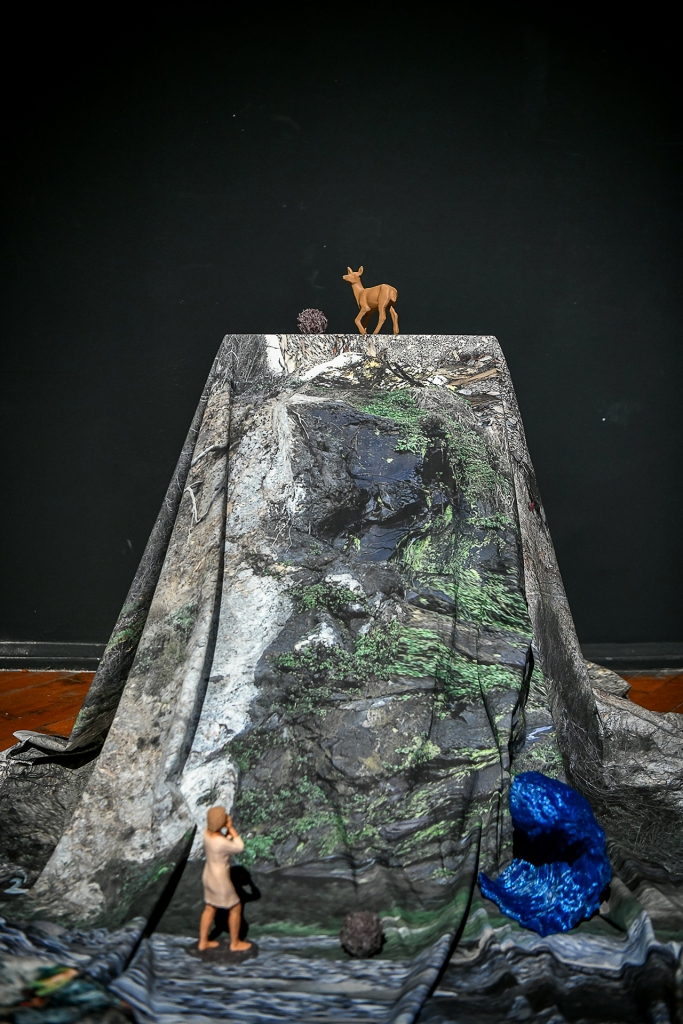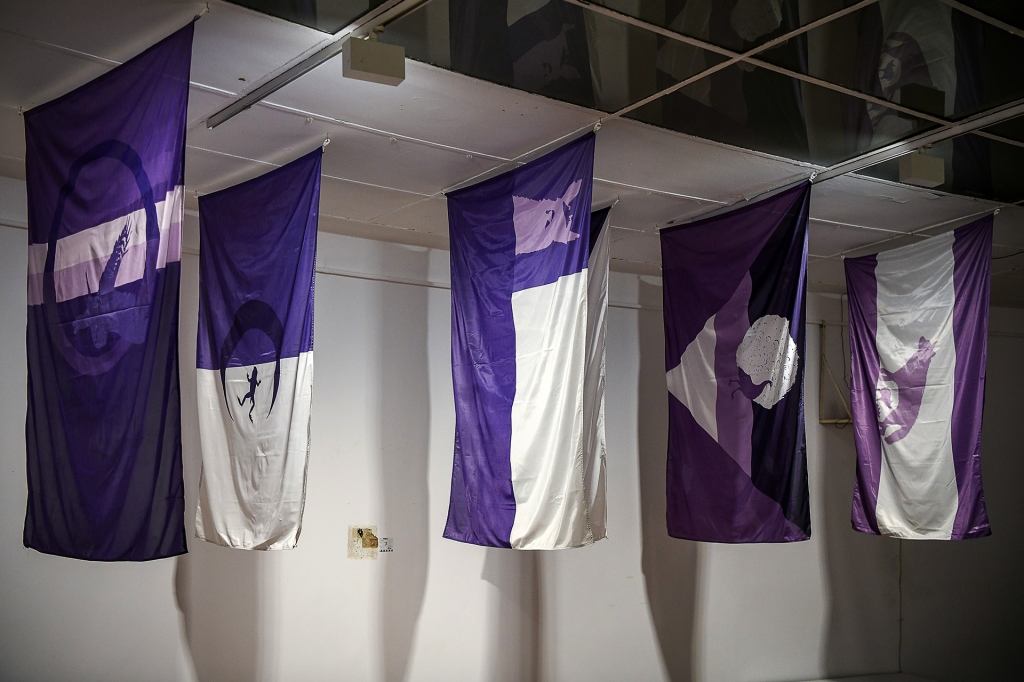review of the exhibition How to Look at Natures? – Art and the Capitalocene
The exhibition How to Look at Natures? – Art and the capitalocene, curated by Suzana Marjanić and Ivana Filip, presents the works of artists who use their personal experiences to document encounters with others; animals, plants, disappearing landscapes, tracking down the foundations of our spiritual, primordial connection with Mother Earth and traces of the lost assets of our Planet. Quiet landscapes, melted glaciers, contaminated rivers, devastated forests, few of them are close to our eyes, and there is almost no information about their disappearance in the daily news. Changes in the climate&landscapes are happening incredibly fast, while the hatch of human consumerism and greed continues to swallow the plant and animal life. It is estimated that only 3% of the Earth’s land surface remains ecologically intact!
Human inability to see the totality of our destructive activities ensures that we fail to solve the crisis systematically and effectively. We need to change the value system, reject capitalist principles, develop strong empathy, feel sorrow and accept that we are wrong, apologize to the Planet, and start doing everyday activities fundamentally different. French intellectual Andre Gorz, who first used the term degrowth, says that it is unrealistic to think that economic growth can still contribute to human well-being. For him, Ecology is the basic element of radical political transformation. All the species we share this Earth with are not here for us, they are here with us. This is also reflected in the selected works of my colleagues from the exhibition, who touched me deeply with their personal stories.
I’ll start with the object of a young designer Erez Nevi Pana, which is artistic and conceptual, designed 100% without animals and based on the principles of non-violence. Eight years ago, he began to question his own ways of eating, and later his own design practice, which eventually led to his doctorate; exploring the possibilities of vegan design. Realizing how much we are surrounded by animal ingredients in basic materials and products, he begins to apply veganism in all aspects of life. And the working environment itself, his studio, from materials to tools, he decided to make without animal cruelty.
In this exhibition, he is showing part of The Banana Project Piece, with the object from performative film Tropical Milan. The installation imagines a future city that has been transformed into a jungle-like climate, due to rising temperatures. He created three objects made from banana fibre: Banana Bag Chair, the Tropical Banana Rocking Chair and the Steamy Banana Hammock, one that I’ve touched, made of banana fibre and luffa – a tropical vine vegetable from the cucumber family.
In order to have complete control over the working material, he has grown own ingredients, that is, banana plants. Nature is always finding a balance by renewing, so Nevi Pana believes that the harmonious state is the core of design and nature. Designers must see the bigger picture, and a h o l i s t i c approach should be implemented in working processes, choosing responsible alternatives that will help us solve our environmental problems.
As an artist and viewer, feeling under my fingers the fineness of the exhibited object, I wonder, what other unknown plants from which this structure, very similar to wool, could be obtained?
Many cultivated plants are rapidly disappearing – such as cocoa, coffee, avocado and bananas – plants that are more vulnerable to diseases than ever. All jewels of various flora and fauna are disappearing, while those that are caged up, raised to feed humankind, remain.
Animal farming creates and emits more greenhouse gasses than all of the world’s traffic combined.
Through the long-standing tradition, habits and rituals outlined by capitalism&accumulation, under the appearance of socialisation and false freedom, we justify our hypocrisy. Most social norms draw from neoliberalism are establishing competition as the guiding principle of human relations, redefining citizens as consumers.
Changing habits and swimming against the current isn’t easy, but it’s certainly not impossible. It only requires a new kind of discipline that teaches us how to deflate our ego us much as possible, to feel connected with other living beings and to put this newness into action through culture. The future is definitely vegan.

Erez Nevi Pana; The Bana Project, photo by Juraj Vuglač
Igor Grubić’s work is a series of five photographs, now empty slaughterhouses, over which are written the author’s text queries in English: “Do animals dream of freedom? Do animals have legal rights? Do animals go to heaven? Do animals survive extinction?” The form of anti-posters calls to moral responsibility, through narrations of the animal path from life to death, from light to darkness. Their terrible fates permeate our neglected and repressed feelings, they become and remain an article on store shelves. And that very article no longer emits screams and howls of pain that is taking its life. The scenes were filmed in a slaughterhouse in northern Italy, in the town of Matera, where the curator printed them in dozens of copies plastering the whole town.

Igor Grubić; Do Animals Have…? Photo by Juraj Vuglač
Lisa Jevbratt’s work, Playset-Falling Deer installation, is the first in a series of playsets depicting unusual events from her life. Big or small, these events stopped and encouraged artist to think deeply about the mystical connection between wild animals and people. The picture on the box and the print on the objects were photographed at the actual scene, which goes like this:
‘’It is early morning on a rugged beach in Northern California. Summer is shifting into fall; the sky is grey and the air is cool. There is no wind. Apart from the rumble of the large pacific swells, it’s quiet. I’m suddenly awakened by a rustle from the cliffs high above. Leaping up from my sleeping bag, I see two small bushes falling down a near-vertical drop right in front of a little waterfall. Then, before my eyes, the jumble of branches transforms into a deer. In shock, anticipating what will happen to the deer as she hits the rocks at the bottom of the tall cliff, I scream and wake my friends up. Time is slowing down to a trickle. Together we witness the deer in free fall. She reaches the ground. She stands up. Unharmed. Unimaginable. The deer darts towards the ocean, past us, out in the big swells. Just as a wave is readying itself to break above her, she spins around. Unscathed by her violent fall and the powerful waves, she runs back up on the sand, towards us. She turns and lopes down the beach, quickly fading into the distance.’’
The magic of Lisa Jevbratt’s work is precisely its form. I imagine how it would be if big and small children, within the school curriculum, design their own games, based on stories that testify to positive encounters and connections between people and wild animals, especially the endangered ones.

Lisa Jevbratt; Playset-Falling Deer, photo by Juraj Vuglač
A film essay by Davor Sanvincenti, Places That We Will Breathe, talks about the disappearance of habitats and animals in a captivating and poetic way. It had its world premiere at the International Festival in Rotterdam, and the Croatian premiere was at Zagreb Dox. In this audiovisual essay, shots of animals, changing seasons, known and unknown landscapes of Istria, mount Risnjak, and the island of Pantelleria in the Sicilian Strait are intertwined. The film is permeated with quotes from Predrag Matvejević, Ken Loach, Chris Marker, Žarko Škugor, R. M. Rilke, Salvatore Murano, Confucius, Chico Mendes, Miru Gataru, Henry David Thoreau, and the author’s grandparents. Simultaneously redefining the concepts of life and death, Sanvincenti very subtly touches on the theme of internal and external freedoms. They are something that cannot be given, they can be taken (from others), and perhaps remind the visitor about the unification of our battle with nature. Through skillful editing, the warmth and the graininess of the image capturing the auras of spaces; landscapes, plants and animals on 16 mm film.
I was magnetically attracted to the shots of birds with the text: “For a bird, there are only two types: its own and the dangerous ones. There are no others. The rest are harmless objects like rocks or trees, or people when they are dead. No pain, nor death, is more frightening for a wild creature, than the fear of man.”

Davor Sanvincenti, Places That We Will Breathe, photo by Juraj Vuglač
Nature is resilient, but not enough to regenerate so quickly as being demolished. Changes are slowly looming and happening, but many living systems are being burned, knocked down, pulled out, poisoned, dusted, contaminated, killed. By naming someone or something an animal, a species lower than man, we give it the social construct ‘one that can be killed’. But over the last decade, it is more and more clear how much damage man’s self-proclaimed domination has done.
Embrace your Empathy, is a piece made by female collective Gustafsson&Haapoja; writer Laura Gustafsson and artist Terike Haapoja. The playful project consists of two parts; flags of nation states modified to include images of animals culturally or biologically important to the region, and a 7-minute animation based on a manifesto for interspecies coexistence. Various all-caps messages appear as part of a seven-minute video loop of animated words and pictures. “Being is” flashes up, followed by, “More than Human” “Obey Your Heart,” pulsates in white on a red screen. “Revolution Through Inclusion” comes up one word at a time on a yellow background, then the screen switches to purple to display the message “Realize the Dream” Fish made out of pixels swim in from the bottom of the picture and exit through the top. A black feline shape runs in place in the middle of a white screen while the word “Release” flashes. The cat dissolves into a swarm of particles and tiny letters until the screen turns black. The next words to appear are “The Hope”. The second part of the work is a purple installation of flags, where each shows a different version of nationality. A purple version of the Canadian flag, with a moose where a maple leaf would normally be. At the same time, breaking down and expanding the meaning of the flag object, the artists are indirectly saying how many autochthonous species define a geographical area&how thoughtlessly we are reacting at their disappearance.

Gustafsson&Haapoja; Embrace Your Empathy, photo by Juraj Vuglač
I’ll draw to a close with the words of climate activist, writer and a Guardian columnist George Monbiot; ‘’So if you don’t fit in; if you feel at odds with the world; if your identity is troubled and frayed; if you feel lost and ashamed, it could be because you have retained the human values you were supposed to have discarded. You are a deviant. Be proud.”
We belong to the world of animals, mammals, with them we breathe the same air and share the same Earth. We have the intelligence and tools to fix things, starting from very personal, small ones, such as reducing and removing meat from our diet, avoiding buying plastic products, cycling more, planting our own garden… The famous contemporary artist Olafur Eliasson says that we should be like clowns! It’s not enough to just recycle, we have to go out to protests in as many numbers as possible and be radically different in everyday activities. The fight for the Earth’s future must not rest on the backs of young activists, all generations, all professions and vocations should enter this fight, each person can contribute.
– – – – – – – – – – – – –
